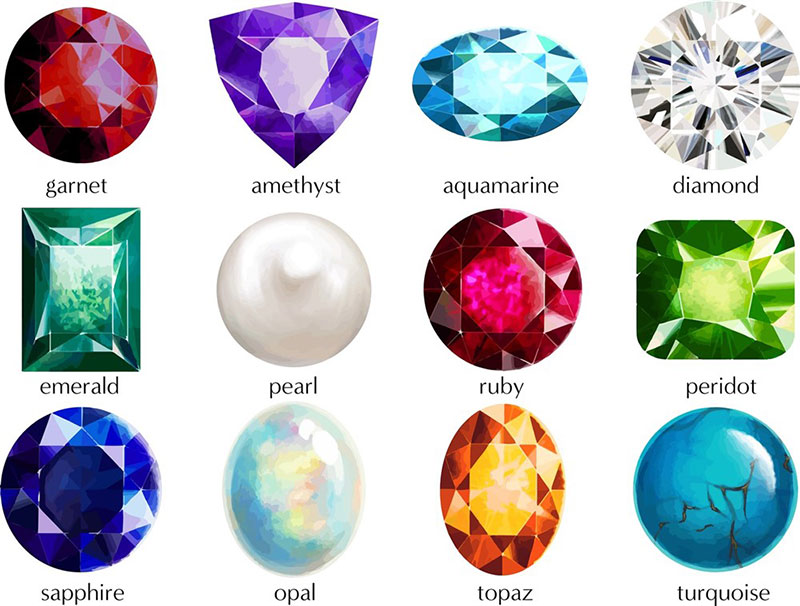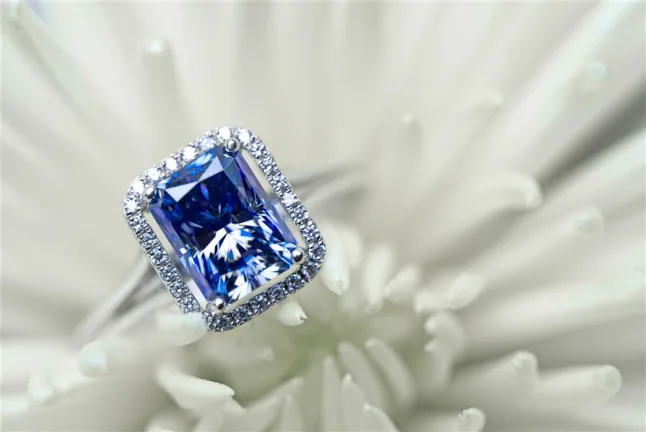Birthstone Engagement Ring Guide | Rare carat
For those seeking a personalized engagement ring, choosing to use your birthstone is a great way to stand out! Fortunately, there is an abundance of information relating to birthstones available at your fingertips. This article will touch on the significance of the different gems and focus on how to wear them. You will see that some months are represented by multiple stones. This doesn’t mean that stones from these months are in any way inferior! Rather, one or more of the stones may be rare, have lower durability, or be cost prohibitive for many. In the end, it just means that you have more options to choose from!

January Birthstone – Garnet:
Discussing garnets is a great way to begin this journey. Garnets are found all over the world, can grow to large sizes, and usually have a bright and clean transparency. It is no surprise that humans have used garnets for thousands of years! There are many species of gem-quality garnets, five of which are considered commercially significant. You are probably most familiar with the red option, yet, one of the greatest attributes of garnet is the wide array of colors that occur naturally; there are plenty of oranges, yellows, reddish purples, and greens to be found.
When it comes to wearing garnet, you have a lot of options. Depending on the species, their hardness can range from a 6.5 to 7.5 on the Mohs Scale of Hardness. It is a hardy gemstone that is non-reactive to light exposure and most chemicals, so it will remain the same color and clarity forever. You can safely wear most garnets in many settings. However, as always, keep in mind that garnet is not as hard as diamond or sapphire. If you expect to be hard on your ring, perhaps avoid open prong settings and instead choose a protective design where the stone is set into the mounting or is bezel-set.
February – Amethyst:
Purple amethyst is the most desired variety of quartz. Its color ranges in saturation from pale lavender to the highly sought-after vivid purple hue. The name “amethyst” originates from a Greek word meaning “a remedy against drunkenness”. Historically, the purple color was associated with royalty and it was thought that amethyst granted the wearer a clear and calm head. More recently, the stone is thought to have healing powers and encourage a spiritual awareness. Amethyst is an affordable gem found all over the world which can grow to a massive size.
With a Mohs hardness of 7, you can cautiously wear amethysts regularly. However, you will notice over time that the stone will accumulate scratches and may require polishing. If you have advanced notice that the ring will be subjected to an abrasive environment, leave it at home.
March – This is one of the lucky months represented by two stones.
• Aquamarine: Aquamarine is a blue relative to emerald with both being species of beryl. From the Latin for “seawater," good aquamarine stones have a beautiful eye-clean clarity and they may have overtones of green. It is also usually light in tone and never reaches the deep blues associated with sapphire. Like amethysts, aquamarine stones can be found in large sizes so well-cut stones are to be expected.
With a Mohs rating of 7.5-8.0, you can absolutely wear aquamarines as engagement rings on a daily basis in most settings.
• Bloodstone: The second gemstone representing March, bloodstone, is a type of semi-transparent to opaque chalcedony with a green base and red spots. There is a lot of lore surrounding bloodstone. As you may have guessed, the red spots are often associated with drops of blood. Some go as far as to assign a religious significance to this stone, claiming the spots reference Christ’s blood on a bed of green grass. It follows, then, that this stone is linked with vitality and youth. Unlike most other gemstones, bloodstone is not typically faceted, rather, it is cut as a cabochon (flat on one side and domed on the other) with the polished flat surface occasionally being carved.
Bloodstones are a softer gemstone and have a Mohs rating of 6.5-7. Thus, they may not be the right stone to use in an engagement ring that you plan to wear regularly.
April – Diamond: Here’s a stone that needs no introduction… the diamond.
The most durable of all gemstones with the maximum Mohs rating of 10, diamonds have become the traditional choice for engagement rings. Resulting from its hardness, diamond is associated with strength and endurance. You can choose the classic colorless option, or if you have a large budget you can choose from the rainbow of fancy colors that diamond can be. Diamond has the power to withstand almost anything that you throw at it and many individuals proudly wear multi-generational stones as engagement rings. You can wear diamonds in prong-settings, tension-settings, and anything else that you can imagine!
May – Emerald:
The captivating green emerald is the perfect stone to represent the month of May. The deep greens, sometimes with blue undertones, are reminiscent of the colors of the lush spring season. Emerald has remained one of the most desired gemstones for millennia across the globe. It has been credited with relieving stress and bolstering intelligence. Some believe that they can foretell the future if place under the tongue!
Like its cousin the aquamarine, emerald has a Mohs hardness of 7.5-8.0. Unlike its cousin, emerald often has inclusions and internal fractures which, if plentiful, may impact the overall durability of the stone. When selecting an emerald for an engagement ring, a higher clarity grade will likely translate to a longer life of the stone. Regardless, it is advisable to set your emerald in a protective design like bezel-settings or inside halos to offer additional protection. However, consider this delicate beauty for a right hand ring that is not worn on the daily.
June – One of only a few months represented by three separate stones.
• Pearls: Because of their aquatic growing conditions, pearls are associated with water. As farming pearls is a recent development, they used to be a rare surprise for divers and were highly prized by the wealthiest of society. Some cultures believed pearls to be the tears fallen from heaven while others associated them with dragons. They are still connected with attributes of purity and innocence. Now grown in both salt and freshwater conditions, modern pearls are available in many different forms. While there will always be a market for the classic white round pearls, you can now find an array of different colors such as black, pistachio, lavender, pink, and gold. Moreover, you have plenty of sizes and shapes to choose from including coin, baroque, oval, ringed and more!
Unfortunately, pearls are not a great choice for engagement rings as they are quite soft with a Mohs rating of only 2.5-3.0. Not only do pearls scratch relatively easily, they also flake and crack upon impact and are sensitive to chemicals. If you do want a pearl engagement ring, plan to wear it only for special occasions.
• Moonstone: The best moonstones feature a billowing blue color (adularescence) floating in a clear and un-fractured background. Most moonstones are cut as cabochons, dome shape mentioned earlier, ideally with the adularescence oriented in the center. Moonstones can be affordable, have experienced multiple periods of popularity over the centuries, and are associated with good luck. Like pearls, moonstone is relatively soft with a rating of 6.0-6.5. It also has strong cleavage planes, which means that they will split if hit from the right direction. It may not be a good idea to wear them as engagement rings.
• Alexandrite: First identified in Russia in the 1830s, alexandrite is a relative newcomer to the gemstone world. This enchanting stone is one of the few naturally color-changing gemstones. The best alexandrite transition, depending on the ambient lighting, goes from a blue-green to a red-purple. You want to find stones with clear and bright colors rather than ones with a muddied appearance. It is not uncommon to find alexandrite that also show a cat’s eye effect. While additional sources outside of Russia have been identified, alexandrite are still relatively rare and the larger, high-quality stones with clear color-changes can be difficult to find.
Fortunately, alexandrite has the highest Mohs rating of all the June stones with an 8.5. If you are lucky enough to find a beautiful stone for your engagement ring, wear it with pride!
July – Ruby: Sometimes called the “King of Colored Stones," rubies are your July birthstone.
The vivid reds of rubies are associated with passion, love, wealth, and fury. Some warriors wore rubies into battle believing that the stones would give them added strength and safeguard their lives. You may find rubies in a variety of red hues which include hints of orange and violet. The most valuable color is called “pigeon’s blood” which has a deep red with purple undertones.
Rubies are part of the corundum species, a family which includes sapphires. In fact, rubies are actually just red-colored sapphires! The first synthetic rubies were created in the late 1800s. A good quality synthetic stone can only be differentiated from the natural under magnification. If you have a smaller budget and don’t mind wearing a man-made stone, a beautiful synthetic ruby may be for you!
Corundum is a fantastic choice for engagement rings because, with a rating of 9, their hardness rating is second only to diamonds.
August:
• Peridot: Thought to possess protective qualities, peridot can sometimes be confused with emerald, however it may have more yellow in it than the more bluish-green May birthstone. Actually, it is among the least expensive of all of the major green gemstones. Generally speaking, the larger the stone, the deeper the color saturation. Peridot may be sold as A or B material. Peridot that is of higher quality and has better color is sold as A material while stones classified as B can be paler and have hints of brown. Interestingly, some peridot is of extraterrestrial origins and has been recovered from meteorites!
Like bloodstones, peridot measures between 6.5 - 7.0 on the Mohs scale and it is sensitive even to mild acids. With regular wear, you will notice scratches accumulating on the surface of the stone and maybe some chips as well. Also, peridot is sensitive to rapid temperature changes. This is another option that is best reserved for special occasions and perhaps jewelry other than rings.
• Spinel: Spinel can be a good engagement ring option because, with a Mohs rating of 8.0, it is a durable stone and occurs naturally in many different colors. You can find purple, orange, blue, violet and green options. Spinel also has a red variety which has historically been confused with ruby. Actually, the Black Prince’s Ruby in the British Imperial State Crown is actually a spinel! The only thing that you need to keep in mind is that the color of your spinel may fade if it is exposed to high heat.
• Sardonyx: Sardonyx is a combination of two types of chalcedony layered on top of each other: sard and onyx. Sard is a reddish-brown color while onyx can be white or black. Sardonyx is often carved to take advantage of the differently colored layers. Unfortunately, sardonyx is also relatively soft with a Mohs 6.5-7.0 rating which makes it a poor option for daily wear. It may also have been treated to intensify the colors and this can be altered when exposed to high heat.
September – Sapphire:
We now return to corundum in the form of sapphire. Corundum occurs in any color that you can imagine but, if you hear the word sapphire on its own, it refers specifically to the blue variety. Sapphires are believed to be the stone of honesty, may shield the wearer from the ill intentions of others, and have medicinal properties. Being a sibling to ruby, sapphire has all of the same qualities of their red counterpart. There are also lovely and affordable synthetic sapphires on the market. One of the most famous engagement rings of all time, by that I mean the ring worn by Princess Diana and now her daughter-in-law Duchess Kate, is a beautiful blue sapphire surrounded by diamonds. Thus, sapphire is a highly durable option that, if cared for properly, may be treasured by multiple generations.
October:
• Opal: Opals have their own unique beauty amongst gemstones. The best opals feature splashes of colors, termed “play of color," including reds, blues and greens. Some believed that opals contained their own light source! Not all opals will have every color. Unfortunately, opals are quite soft with a rating of 5.0-6.5. As a result, you may find opals that are strengthened by having a sturdy base attached to them (called a doublet) or find a stone sandwiched between two protective layers (called triplets). Opals are incredibly delicate and will likely fracture (craze) over time and therefore, not suitable for daily wear. To better protect your stone, they should be placed in settings which protect them such as halos and bezel settings. Avoid dry temperatures, high heat and any chemicals whatsoever.
• Tourmaline: Tourmalines occur in many colors including blues, greens, pinks, reds and black. Some crystals include multiple colors. Stones with a red interior and green exterior are nicknamed “watermelon tourmaline” because they resemble slices of this fruit. Various colors embody different virtues: pinks are connected to love, greens to bravery, and blacks to safety. With a hardness rating of 7.0-7.5, tourmaline is a better option than opal for engagement ring stones, but you still should exercise caution when wearing it.
November:
• Topaz: The history of topaz reaches back many centuries. The stone occurs in hues of pink, orange, yellow, brown, red and pale blues. Darker blue topaz usually results from artificial treatment and you may see a version flaunting a rainbow of colors called Mystic Topaz, the result of a manmade coating placed over a colorless stone. Imperial topaz refers to a popular pinkish orange color. Topaz is interesting in that it has a high Mohs "hardness" score of 8.0, but has a low "toughness" and is vulnerable to scratches and chips. This stone is also sensitive to heat, excessive sunlight and some chemicals. Thus, topaz is somewhat of a fussy stone that is not suited to careless wear.
• Citrine: Like the amethyst, citrine is part of the quartz family. It occurs naturally in shades of yellow, and orange browns. However, much of the material on the market began life as amethyst and was artificially treated with heat to attain warmer color. When searching for amethysts or citrine, you will inevitably come across the ametrine, a lovely single quartz crystal featuring both the purple amethyst and yellow citrine, simultaneously. Due to citrine affordability and availability in large sizes, it is a highly desired gemstone. Associated with serenity, it is often confused with its fellow November birthstone, yellow topaz. Citrine has many of the same qualities as amethyst, regarding hardness and durability, so it not a great choice for daily use.
December:
• Tanzanite: First discovered in 1962, tanzanite is a newcomer to the gemstone market. A transparent stone, tanzanite is similar to sapphire in that it features a deep blue color. Unlike sapphire, however, tanzanite lovers crave its unique purple or violet flashes. With a Mohs score of 6.0-7.0, it is not as durable as corundum. You can still wear it as an engagement stone, but remember that it is sensitive to rapid temperature changes, acids, and scratches relatively easily. However, if you set your tanzanite in a protective mounting and don’t wear it frequently, you can enjoy its beauty for many years!
• Turquoise: Humans have adorned themselves with turquoise for many millennia reaching across the world. Turquoise was used in ancient Egypt, the Far East, and in the Americas. As a result of its long history, there is a great deal of lore surrounding turquoise: some believe it brings good health and wealth to the wearer, others credit the stone with promoting a successful hunt while protecting horse riders from falling. While most think of turquoise as blue, it is found in green and yellow colors. Dark "matrixing" characteristics make this stone easily identifiable, however, the often considered the finest of turquoise, some will have no matrixing at all. The most valued hue is called “Persian blue”.
As turquoise is such a soft material with a rating of 5.0-6.0, it is often impregnated with epoxy to harden it. A porous stone, turquoise is often dyed to improve the color. The presence of any treatment is detrimental to the value of the stone. The combination of softness with the high porosity makes for an overall delicate stone.
• Zircon: Finally, the last birthstone on the list is zircon. Zircon is another one of those stones that occurs in various colors. You may see warm colors like yellow, red, and orange alongside cool blues and greens. Historically, the colorless variety has been confused with diamond. Unfortunately, zircon is soft with a rating of 7.0-7.5 and with wear, its facet edges will scratch. If you really want a zircon as your engagement stone, make sure that it is fitted inside a protective setting and always worn with consideration!
Choosing to use your birthstone in your engagement ring can double the meaning to an already significant piece of jewelry. If you take proper care of your stone, it will stand as an enduring symbol of love and commitment.

